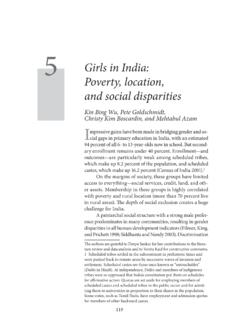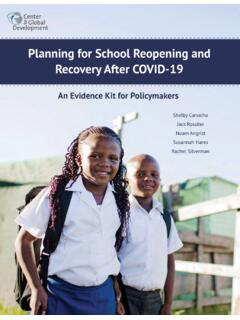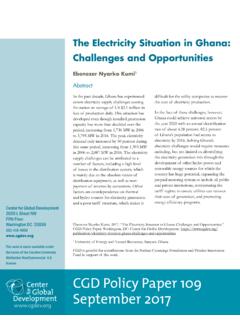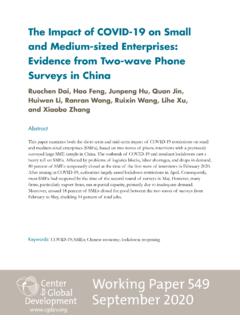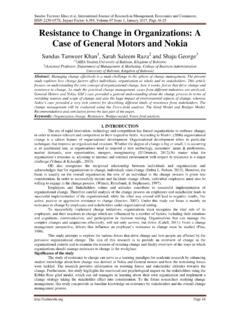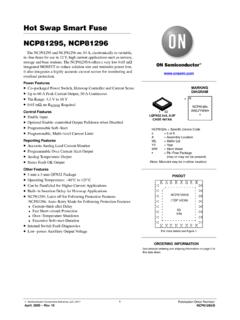Transcription of COVID-19 Vaccine Predictions: Using Mathematical Modelling ...
1 COVID-19 Vaccine Predictions: Using Mathematical Modelling and Expert Opinions to Estimate Timelines and Probabilities of Success of COVID-19 . Vaccines Anthony McDonnell, Robert Van Exan, Steve Lloyd, Laura Subramanian, Kalipso Chalkidou, Adrian La Porta, Jiabin Li, Eddine Maiza, David Reader, Julie Rosenberg, Jack Scannell, Vaughan Thomas, Rebecca Weintraub, and Prashant Yadav Abstract We collected publicly available information, interviewed experts, and used our diverse range of expertise to analyse and model the COVID-19 Vaccine portfolio. There is significant uncertainty surrounding the development, approval and manufacturing of COVID-19 . vaccines. We find that the chances of developing a safe and efficacious Vaccine are high but it will not occur in the immediate future, and it is unlikely to be the silver bullet that resolves the pandemic and returns our world to normal. Using inputs generated from expert interviews, our Modelling suggests that there is a 50 percent chance that by the end of April 2021 there will be a Vaccine safe and efficacious enough to win approval from a stringent regulator; by the end of 2021, this rises to 85 percent.
2 Inputs more optimistic or pessimistic than those we gained through expert interviews lead to very different results. We also modelled how long it would take to manufacture COVID-19 vaccines once they are approved. Our Modelling suggests that it will probably take more than a year to produce Center for Global Development enough vaccines to inoculate the world's 50 million medical staff, and that it could be 2055 L Street NW. September 2023 before we have enough doses for the whole world. It is not clear that these Fifth Floor early vaccines will be efficacious enough to end the COVID-19 crisis. The vast majority of Washington DC 20036. 202-416-4000. experts we spoke with predict that first-generation vaccines will not be effective enough to end the pandemic on their own, and that it will take longer to develop vaccines that fully prevent infection. This means that the world must be prepared to commit to other public This work is made available under health measures to control the spread of the virus for years, and should invest in a wider, the terms of the Creative Commons more diversified portfolio of vaccines through better international collaboration and market Attribution-NonCommercial incentives, as well as focus on diagnostics and treatments.
3 All this while carefully managing license. the collateral damage from the ongoing policy response. CGD Policy Paper 183. October 2020. COVID-19 Vaccine Predictions: Using Mathematical Modelling and Expert Opinions to Estimate Timelines and Probabilities of Success of COVID-19 Vaccines Anthony McDonnell and Kalipso Chalkidou Center for Global Development Robert Van Exan Immunization Policy and Knowledge Translation Steve Lloyd Queen Mary University of London Laura Subramanian, Julie Rosenberg, and Rebecca Weintraub Ariadne Labs Adrian La Porta, Jiabin Li, and David Reader Bryden Wood Eddine Maiza Independent Jack Scannell University of Edinburgh Vaughan Thomas Tillingbourne Consulting and University College London Prashant Yadav Center for Global Development and INSEAD. McDonnell, Van Exan, Lloyd, Subramanian, Chalkidou, La Porta, Li, Maiza, Reader, Rosenberg, Scannell, Thomas, Weintraub, and Yadav, 2020. COVID-19 Vaccine Predictions: Using Mathematical Modelling and Expert Opinions to Estimate Timelines and Probabilities of Success of COVID-19 Vaccines.
4 CGD Policy Paper 183. Washington, DC: Center for Global Development. COVID-19 - Vaccine -predictions Center for Global Development The Center for Global Development works to reduce global poverty 2055 L Street NW and improve lives through innovative economic research that drives Washington, DC 20036 better policy and practice by the world's top decision makers. Use and dissemination of this Policy Paper is encouraged; however, reproduced copies may not be used for commercial purposes. Further usage is (f) permitted under the terms of the Creative Commons License. The views expressed in CGD Policy Papers are those of the authors and should not be attributed to the board of directors, funders of the Center for Global Development, or the authors' respective organizations. Contents Preface .. 1. Executive Summary .. 3. Introduction .. 8. Methodology .. 9. The 13. Modelling Manufacturing .. 15. Generating Model Inputs from the Expert Interviews.
5 17. Model 25. Recommendations .. 37. Next 40. 41. Acknowledgements .. 42. Appendix A. Entities Developing Candidate 43. Appendix B. Experts Interviewed .. 46. Appendix C. Modelling Research and Development .. 47. Appendix D. COVID-19 Vaccines Interview Guide .. 55. Appendix E. Importance of Funding to Vaccine Success .. 59. Appendix F. Background Information on 61. Appendix G. Main Manufacturing Capacity Model Assumptions .. 77. Appendix H. Sensitivity Analysis of the R&D Model .. 79. 1. Figures Figure Projected probability that at least one COVID-19 Vaccine is approved, October 2020 September 2023 ..5. Figure 1. Overview of models 14. Figure 2. Projected probability of success of a phase 3 trial of the seven platforms for COVID-19 Vaccine , according to interviewed experts 20. Figure 3. Projected probability of at least one Vaccine approval, October 2020 . September 2023 . 26. Figure 4. Projected probability of first Vaccine being approved, October 2020.
6 September 2023 . 26. Figure 5. Probability of success against approval rate for every Vaccine in the portfolio, colour coded by platform 30. Figure 6. Projected timelines for manufacturing COVID-19 vaccines, by platform .34. Figure 7. Vaccinating the population, by target group .35. Figure 8. Time required to manufacture enough of one Vaccine to meet targets, by platform ..36. Figure 9. Projected production of vaccines, by platform and target .36. Figure Number of COVID-19 vaccines being developed, by continent ..43. Figure Experience of institutions developing candidate vaccines .44. Figure Options for overlapping trails . 49. Figure Triangle distribution for randomly selecting month lengths ..50. Figure Flow chart for the model ..51. Figure Changes in probability of success after funding adjustments .53. Figure Production of drug substance and manufacture of drug product for alive attenuated virus ..62. Figure Funding of and types of institutions working on protein subunit based Vaccine 65.
7 Figure Production of drug substance and manufacture of drug product for an inactivated virus .64. Figure Funding of and types of institutions working on an inactivated virus Vaccine 65. Figure Production of drug substance and manufacture of drug product for an inactivated virus Vaccine ..66. Figure Funding of and types of institutions working on an RNA Vaccine .68. Figure Production of drug substance and manufacture of drug product for an RNA. Vaccine 69. Figure Funding of and types of institutions working on a nonreplicating viral vector Vaccine .71. Figure Funding of and types of institutions working on a replicating viral vector Vaccine ..71. Figure Production of drug substance and manufacture of drug product for replicating and non-replicating viral vaccines ..73. Figure Funding of and types of institutions working on a DNA Vaccine 74. Figure Production of drug substance and manufacture of drug product for a DNA. Vaccine 76. Tables Table 1.
8 Number of Vaccine candidates in each funding category 10. Table 2. How we categorised COVID-19 Vaccine platforms 12. Table 3. Historical likelihood and expert forecasts of probability of success of well- funded COVID-19 candidates, by phase (percent) 19. Table 4. Historical and expert projections of time needed to complete each phase of Vaccine development 21. Table 5. Timelines for different platforms . 22. Table 6. Risk correlations by platform 23. Table 7. Probability of Vaccine approvals, by platform, up to September 2023 27. Table 8. Building a low-risk Vaccine portfolio . 29. Table 9. Probability of Vaccine approval by September 2023 .. 31. Table 10. Probability of Vaccine approval by September 2023, based on current phase of development 31. Table 11. Probability of success for optimistic, pessimistic, and standard scenarios 32. Table 12. Number of Vaccine doses need to vaccinate target groups . 33. Table Experts' assessment of speed of Vaccine development and probability of success, by type of developer.
9 59. Table Positive and negative factors affecting development of a Vaccine based on live attenuated virus ..62. Table Positive and negative factors affecting development of a Vaccine based on protein subunit 64. Table Positive and negative factors affecting development of a Vaccine based on an inactivated virus .66. Table Positive and negative factors affecting development of an RNA-based Vaccine 69. Table Positive and negative factors affecting development of a Vaccine based on a non-replicating viral vector .72. Table Positive and negative factors affecting development of Vaccine based on a replicating viral vector .73. Table Positive and negative factors affecting development of a DNA-based Vaccine 75. Preface This paper draws together numerous data sources to estimate timelines and probabilities of developing, approving and manufacturing a COVID-19 Vaccine . It does this in the context of significant uncertainty through applying well-established methods for combining the limited data we have on past successes and the current state of affairs with expert judgement.
10 To the latter, we provided each of our experts with past data of success for each stage as our baseline estimates and asked them to update these with their subjective knowledge. We then fed this information into a model which runs thousands of simulations of potential futures to provide us with our probabilities of success. This is work in progress: the data are scarce, the experts few and the stakes high. But this is precisely why this work is so important. Three broad observations and related policy recommendations warrant highlighting here. 1. A Vaccine for COVID-19 will take time to develop, and early vaccines are unlikely to be 100 percent effective or manufactured in large enough numbers for the whole of the world's population in a short time period. Governments and health agencies should plan for a long process dealing with COVID-19 and minimize collateral damage from health and economic shock of the COVID-19 response. Our analysis confirms our earlier position that getting to a Vaccine is not a linear process.

